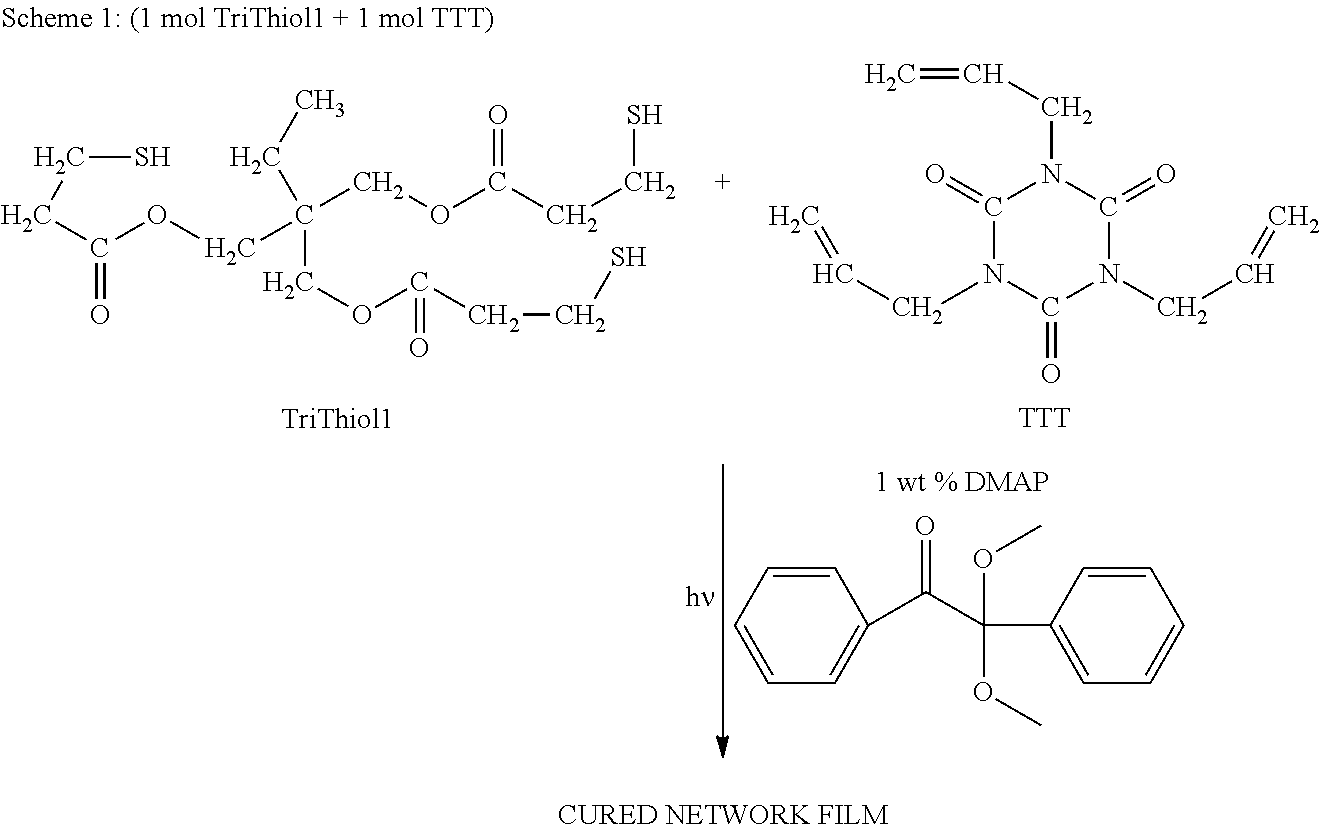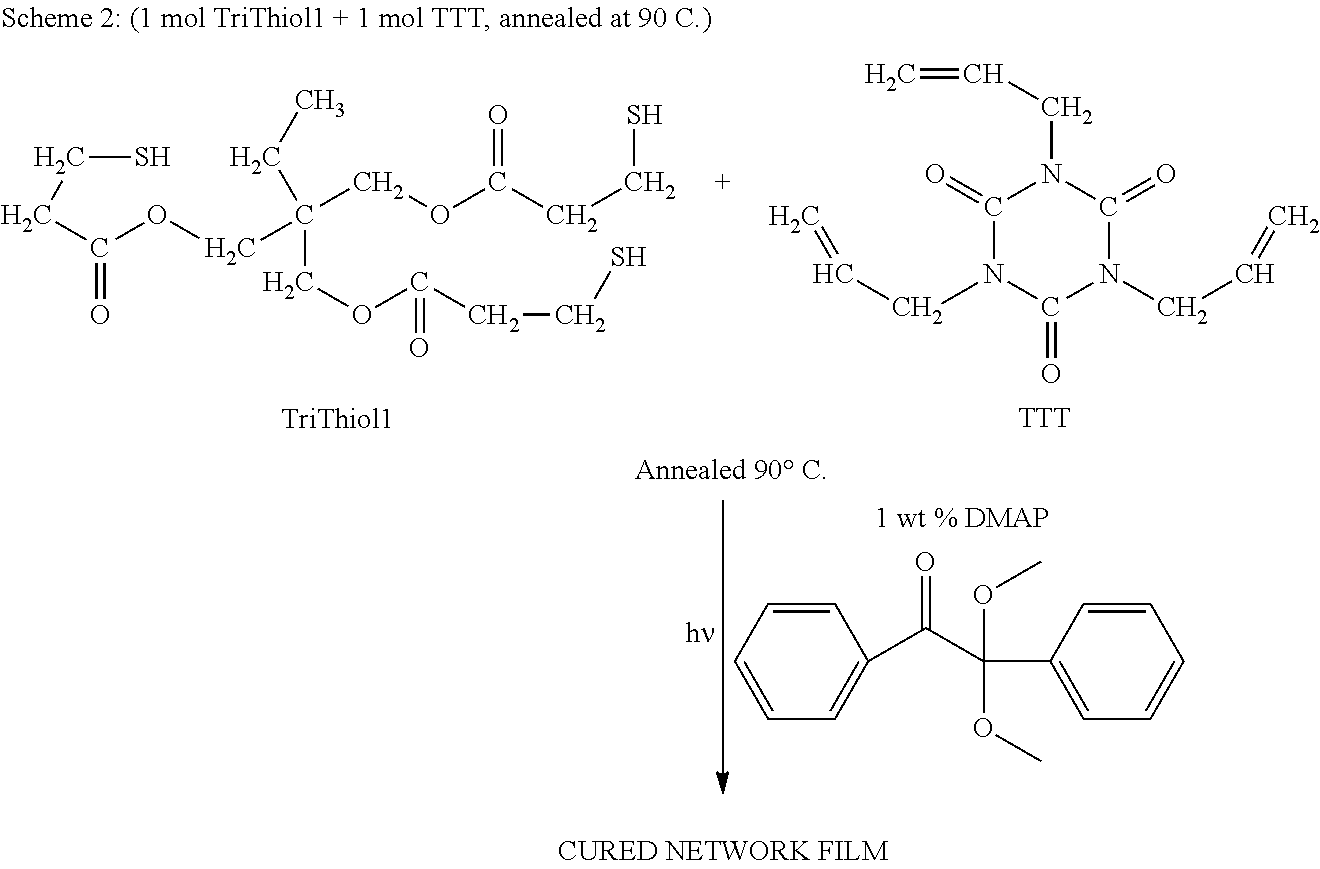Photocuable thiol-ene low gas permeability membranes
a technology of thiol-ene and low gas permeability, which is applied in the field of photocuable thiolene low gas permeability membranes, can solve the problems of severe reduction of the need for thermoforming equipment, so as to improve the service life of packed materials, improve the gas barrier, and accelerate the curing
- Summary
- Abstract
- Description
- Claims
- Application Information
AI Technical Summary
Benefits of technology
Problems solved by technology
Method used
Image
Examples
example 1
TriThiol+TTT Recipe and TetraThiol1+TTT Recipe
[0027]Trimethylolpropane tris(3-mercaptopropionate) (“TriThiol”) is combined with 1,3,5-Triallyl-1,3,5-triazine-2,4,6(1H,3H,5H)-trione (“TTT”) at a 1:1 molar ratio. 1 wt % photoinitiator (Alpha,alpha-dimethoxy-alpha-phenylacetophenone, abbreviated DMAP, sold as Irgacure® 651) is added to the mixture and then sonicated for 10 minutes or until solution is clear and free of bubbles. The mixture is then drawn down onto a glass plate at 200 micrometers thickness and cured using 10 passes at 10 ft / min feed speed under a Fusion UV curing line system with a D bulb (400 W / cm2) (Scheme 1). The cured films were analyzed by a Mocon OxTran 2 / 21 using ASTM D 3985-81 to assess the data. Samples of TriThiol+TTT were prepared and cured similarly followed by annealing at 90° C. (Schemes 2 and 3). TriThiol+TTT samples were also subjected to annealing at 90° C. in air to see if additional changes in the permeability occurred: no significant changes occurred...
example 2
Modified 4-Functional Thiol Synthesis and Modified TetraThiol (TetraThiol1)+TTT Photopolymerization.
[0031]The TetraThiol1 was reacted (Scheme 4) with a number of double bonds functionalized with groups (hydroxylethylacrylate, cyano, chloro, amide, alkylacrylates) designed to alter the properties of the thiol essentially creating totally new thiols of functionality 3 (average functionality of a statistical mixture) with the type of attached groups which are purported (or can be deduced to be) effective in altering the gas barrier properties of polymers. (Morris Salame, Polymer Engineering and Science, vol.26, pp. 1543-1546, 1987). The double bond functionalized may be acrylonitrile, acrylamide, hydroxyethylacrylate, dichloroethylene, fumaramide, maleamide, dicyanoethylene and the like with at least one strong electronic withdrawing groups attached to the —C═C— bond, with the general structure ABC=CDE with preferable at least one of the substituent groups ABDE being an electron withdr...
example 3
TetraThiol1+TTT +Acrylonitrile Photopolymerization
[0042]In this example as shown in Scheme 6, the final film was generated without first reacting one of the thiol groups on the TetraThiol1 as in Example 2 using an amine catalyzed Michael addition. Rather, an excess of the acrylonitrile was mixed into the reaction mixture of the TetraThiol1+TTT such that the total concentration of the acrylonitrile is greater than achieved by first functionalizing one of the thiol groups out of the four thiols in each TetraThiol1 molecule. This eliminates the initial thiol conjugate reaction between one of thiols and the electron poor acrylonitrile group. The result is thought to be a film with greater concentration of converted acrylonitrile units and a higher gas barrier film. It is also different in that some unattached acrylonitrile homopolymer is believed to be present in the final film.
[0043]TetraThiol1+Acrylonitrile+TTT Recipe (mixture): Pentaerythritol tetrakis(3-mercaptopropionate) (“TetraTh...
PUM
| Property | Measurement | Unit |
|---|---|---|
| wt % | aaaaa | aaaaa |
| thicknesses | aaaaa | aaaaa |
| thicknesses | aaaaa | aaaaa |
Abstract
Description
Claims
Application Information
 Login to View More
Login to View More - R&D
- Intellectual Property
- Life Sciences
- Materials
- Tech Scout
- Unparalleled Data Quality
- Higher Quality Content
- 60% Fewer Hallucinations
Browse by: Latest US Patents, China's latest patents, Technical Efficacy Thesaurus, Application Domain, Technology Topic, Popular Technical Reports.
© 2025 PatSnap. All rights reserved.Legal|Privacy policy|Modern Slavery Act Transparency Statement|Sitemap|About US| Contact US: help@patsnap.com



